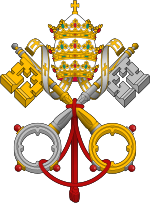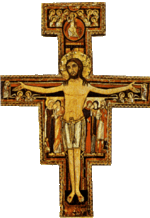Pope Lucius I
| Saint Lucius I | |
|---|---|
 |
|
| Papacy began | June 25, 253 |
| Papacy ended | March 5, 254 |
| Predecessor | Cornelius |
| Successor | Stephen I |
| Personal details | |
| Birth name | Lucius |
| Born | ??? Rome, Roman Empire |
| Died | March 5, 254 Rome, Roman Empire |
| Other Popes named Lucius | |
| Papal styles of Pope Lucius I |
|
|---|---|
 |
|
| Reference style | His Holiness |
| Spoken style | Your Holiness |
| Religious style | Holy Father |
| Posthumous style | Saint |
Pope Saint Lucius I was Pope from June 25, 253 to March 5, 254.
St. Lucius was born in Rome at an unknown date; nothing is known about his family except his father's name, Porphyrianus. He was elected probably on June 25, 253, and died on March 5, 254. His election took place during the persecution which caused the banishment of his predecessor Pope Cornelius, and he also was banished soon after his consecration, but succeeded in gaining permission to return.
He is praised in several letters of St. Cyprian (see Epist. lxviii. 5) for condemning the Novationists for their refusal to readmit to communion Christians who repented for having lapsed under persecution.
His feast day is March 5, on which date he is commemorated in the Roman Martyrology in the following terms: "In the cemetery of Callistus on the Via Appia, Rome, burial of Saint Lucius, Pope, successor of Saint Cornelius. For his faith in Christ he suffered exile and acted as an outstanding confessor of the faith, with moderation and prudence, in the difficult times that were his."[1]
His feast did not appear in the Tridentine Calendar of Pope Saint Pius V. In 1602 it was inserted, under the date of March 4 into the calendar of saints for use wherever the Roman Rite is celebrated. With the insertion in 1621 on the same date of the feast of Saint Casimir, the celebration of Pope Lucius was reduced to a commemoration with Saint Casimir's Mass. It remained so until 1969, when Pope Lucius's feast was moved in the Roman Martyrology to the day of his death and omitted from the General Calendar, partly because of the baselessness of the title of "martyr" with which he had previously been honoured.[2]
In spite of what is mistakenly stated in the Liber Pontificalis, he did not in fact suffer martyrdom.[3] The persecution of Valerian in which he was said to have been martyred is known to have started later than March 254, when Pope Lucius died.
Tomb
His tombstone is still extant in the catacomb of Callixtus. His relics were later brought to the church of Santa Cecilia in Trastevere, along with the relics of St. Cecilia and others. His head is preserved in a reliquary in St. Ansgar's Cathedral in Copenhagen, Denmark. This relic was brought to Roskilde around the year 1100, after St. Lucius had been declared patron of the Danish region Zealand. There had been demons at large at the Issefjord at Roskilde city, and as they declared that they feared nothing but Lucius' skull, this had to be brought to Denmark, whereupon peace took reign of the fjord again.[4] After the Reformation the skull was taken to the exhibition rooms of king Frederik III in Copenhagen, where it was on exhibit along with the petrified embryo a woman had carried inside her for 28 years, as well as other monstrosities the king had collected—until it was transferred to Copenhagen's National museum. Pope St. Lucius' head is among the few relics to have survived the Reformation in Denmark.
References
- ↑ Romae via Appia in coemeterio Callisti, depositio sancti Lucii, papae, qui, sancti Cornelii successor, pro Christi fide exsilium passus est et, fidei confessor eximius, in angustiis tempestatibus suis moderatione ac prudentia se gessit [Martyrologium Romanum (Libreria Editrice Vaticana, 2001 ISBN 99-209-7210-7), die 5 martii].
- ↑ Calendarium Romanum (Libreria Editrice Vaticana 1969), pp. 88 and 118
- ↑ St. Lucius I; "There are no grounds for counting St Lucius among the martyrs, since he is listed in the Depositio Episcoporum" [Calendarium Romanum (Libreria Editrice Vaticana, 1969), p. 118]
- ↑ R. Broby-Johansen: Det gamle København (page 164), edited by Thanning and Appel, Copenhagen 1978, ISBN 87-4123-6347-7
 This article incorporates text from a publication now in the public domain: Chisholm, Hugh, ed (1911). Encyclopædia Britannica (Eleventh ed.). Cambridge University Press.
This article incorporates text from a publication now in the public domain: Chisholm, Hugh, ed (1911). Encyclopædia Britannica (Eleventh ed.). Cambridge University Press.- This article includes content derived from the Schaff-Herzog Encyclopedia of Religious Knowledge, 1914, which is in the public domain.
External links
- "Pope St. Lucius I". Catholic Encyclopedia. 1913. http://www.newadvent.org/cathen/09411a.htm.
- Opera Omnia
| Catholic Church titles | ||
|---|---|---|
| Preceded by Cornelius |
Bishop of Rome Pope 253–254 |
Succeeded by Stephen I |
|
|||||||||||||||||||||||||||||||||||||||||||||
|
|||||||||||||||||||||||||||||||||||||||||

